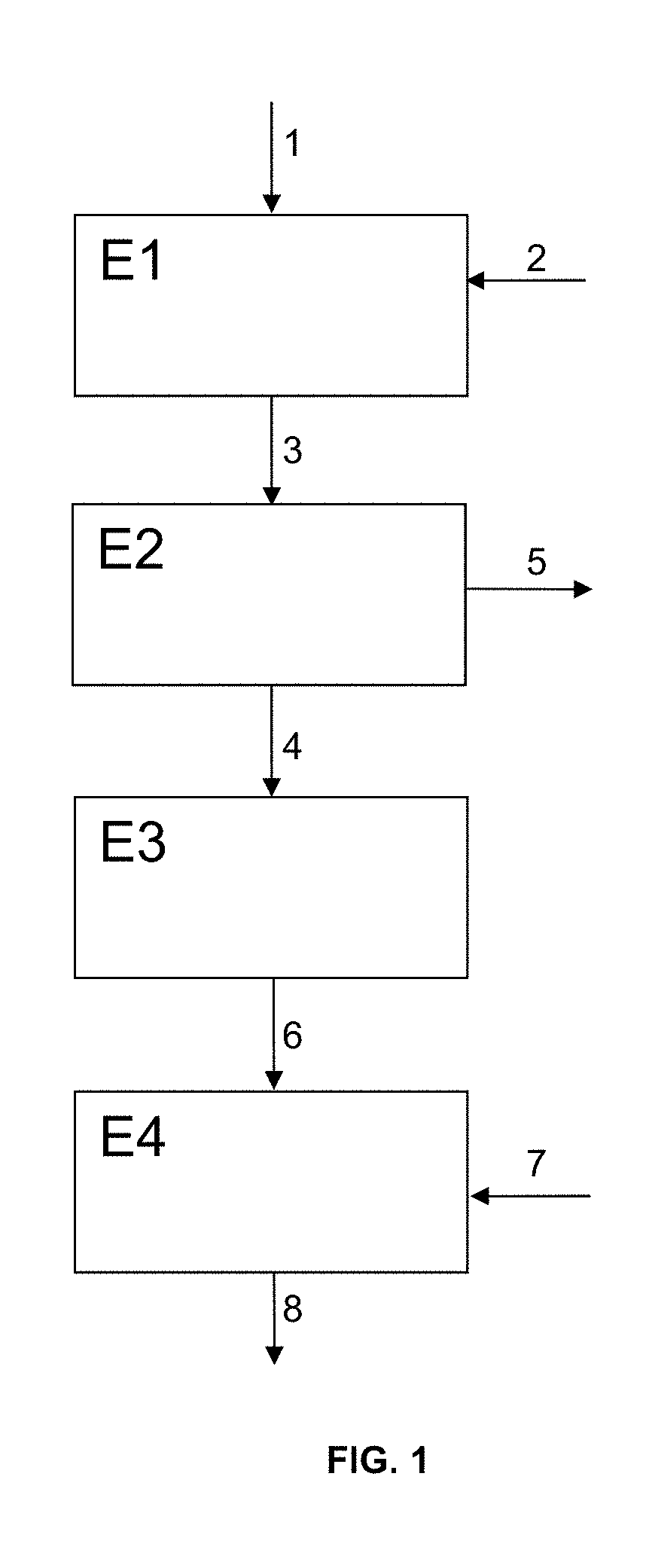Method and plant for chemical looping oxidation-reduction combustion of a gaseous hydrocarbon feedstock with intermediate catalytic steam reforming of the feed
a gaseous hydrocarbon feedstock and catalytic steam reforming technology, which is applied in the field of chemical looping oxidation reduction combustion (clc) of hydrocarbons, can solve the problems of significant constraints on the fume filtration system, nickel oxide has a high toxicity value, and reduce the selection of possible materials, so as to reduce the size of the reactor used, improve the clc process performance, and reduce the effect of the size of the reactor
- Summary
- Abstract
- Description
- Claims
- Application Information
AI Technical Summary
Benefits of technology
Problems solved by technology
Method used
Image
Examples
example 1
[0139]Example 1 is an example embodiment of the CLC process as implemented in FIG. 2.
[0140]We consider a chemical looping combustion plant operating natural gas containing almost 100% methane (CH4). The composition of the gas, in volume fraction, is as follows:
CH495.05%C2H61.77%C3H80.57%C4H100.27%C5H120.11%CO20.76%N21.44%He0.03%
[0141]The oxygen carrier is a manganese-based metal oxide whose redox pair involved is Mn3O4 / MnO.
[0142]The dimensioning of the first reduction reactor depends on the targeted methane conversion level so as to produce sufficient vapour for the steam reforming step.
[0143]In order to define the feed conversion and vapour production conditions, an experimental study is conducted in a 30 mm-diameter quartz reactor laden with 25 g SMR catalyst. The catalyst consists of pierced Ni / Al2O3 pellets (BASF SG-9301 containing 16.5 wt. % nickel oxide), crushed and screened between 1.6 mm and 3.15 mm (mean diameter 2.4 mm). The catalyst fixed bed in this reactor simulates th...
example 2
[0148]Example 2 is a simplified numerical example illustrating the heat capacity of the oxygen-carrying solid available in the case of a plant according to a series configuration as illustrated in FIG. 2 and a plant according to a parallel configuration as illustrated in FIG. 3.
[0149]We consider a 200-MWth CLC plant treating a gaseous hydrocarbon feed consisting of 100% methane (CH4).
[0150]We consider a methane flow rate mCH4 of 4 kg / s (i.e. 250 mol / s) and a total metal oxide solid flow rate of 805 kg / s.
[0151]Assuming a methane conversion ratio X equal to 40% in the first reduction reactor, the gas stream at the first reduction reactor outlet, entering the steam reforming zone at the base of the second reduction reactor, then consists of unconverted CH4 (150 mol / s), CO2 (100 mol / s) and H2O vapour (200 mol / s).
[0152]We assume that the temperature of the oxygen-carrying solid leaving oxidation reactor (110, 210) is 1000° C. We assume that:[0153]in the series configuration, the temperat...
example 3
[0164]Example 3 is a simplified numerical example illustrating the pressure drop management in a plant according to the invention.
[0165]We take the configuration given in Example 1, except for the methane residence time in the fixed bed: we consider in this example a methane residence time of 0.2 s in the SMR catalyst fixed bed.
[0166]In order to minimize the pressure drop in the SMR catalyst fixed bed, the diameter in the bottom of the second reduction reactor comprising the fixed bed is multiplied by 2. The gas velocity is thus divided by 4.
[0167]Considering a gas velocity in the second reduction reactor of 7 m / s to ensure transport of the oxygen-carrying solid, the gas velocity at the outlet of the SMR catalyst fixed bed is estimated at 1.75 m / s (gas velocity in the second reactor divided by 4). At the fixed bed inlet, considering a 170% molar expansion of the SMR reaction, the gas velocity is 1.75 / 1.7=1.0 m / s. The average gas velocity at the fixed bed thus is (1+1.75) / 2=1.35 m / s....
PUM
| Property | Measurement | Unit |
|---|---|---|
| temperature | aaaaa | aaaaa |
| temperature | aaaaa | aaaaa |
| temperature | aaaaa | aaaaa |
Abstract
Description
Claims
Application Information
 Login to View More
Login to View More - R&D
- Intellectual Property
- Life Sciences
- Materials
- Tech Scout
- Unparalleled Data Quality
- Higher Quality Content
- 60% Fewer Hallucinations
Browse by: Latest US Patents, China's latest patents, Technical Efficacy Thesaurus, Application Domain, Technology Topic, Popular Technical Reports.
© 2025 PatSnap. All rights reserved.Legal|Privacy policy|Modern Slavery Act Transparency Statement|Sitemap|About US| Contact US: help@patsnap.com



